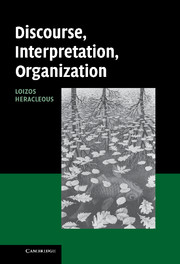Book contents
- Frontmatter
- Contents
- List of figures
- List of tables
- Preface
- 1 Images of discourse: interpretive, functional, critical, and structurational
- 2 Interpretive approaches to organizational discourse
- 3 Functional approaches: metaphor in organization change and development
- 4 Critical approaches: Michel Foucault's conceptions of discourse
- 5 A structurational approach to discourse
- 6 Analyzing discourse I: discourse as situated symbolic action
- 7 Analyzing discourse II: a tale of three discourses
- Index
- References
7 - Analyzing discourse II: a tale of three discourses
Published online by Cambridge University Press: 22 September 2009
- Frontmatter
- Contents
- List of figures
- List of tables
- Preface
- 1 Images of discourse: interpretive, functional, critical, and structurational
- 2 Interpretive approaches to organizational discourse
- 3 Functional approaches: metaphor in organization change and development
- 4 Critical approaches: Michel Foucault's conceptions of discourse
- 5 A structurational approach to discourse
- 6 Analyzing discourse I: discourse as situated symbolic action
- 7 Analyzing discourse II: a tale of three discourses
- Index
- References
Summary
This chapter provides an empirical illustration of a structurational view of discourse, outlined in chapter 5, where discourse is seen as a duality constituted by two dynamically interrelated levels: the surface level of communicative actions and the deeper level of discursive structures, recursively linked through the modality of actors' interpretive schemes. Within this broad view of discourse, an analytical approach based on rhetoric and hermeneutics was employed to analyze the discourses operating in the UK operations of People Associates (PA), a global consulting firm focusing on people issues, in the context of PA's organizational change program that took place in the mid-1990s.
This study had three aims. First, to clarify the nature of “modes of discourse” (Giddens, 1984: 33) in organizational settings. Second, to explore how, if at all, modes of discourse in specific social settings are interrelated. Finally, the study aimed to explore the constructive potential of modes of discourse in their social and organizational context. Empirical analysis revealed three modes of discourse, which I have labeled the dominant discourse, the strategic change discourse, and the marginalized counter-discourse. As will be discussed in detail later, the dominant discourse is patterned in terms of enthymeme structures (rhetorical structures of argumentation that draw from the premises already held by the audience, in particular social contexts) that possess both normative and positive, action-oriented, elements. The strategic change discourse draws its legitimacy by being located in the structures and constructions of the dominant discourse, exhibiting a co-optive relationship with the dominant discourse.
Information
- Type
- Chapter
- Information
- Discourse, Interpretation, Organization , pp. 165 - 198Publisher: Cambridge University PressPrint publication year: 2006
